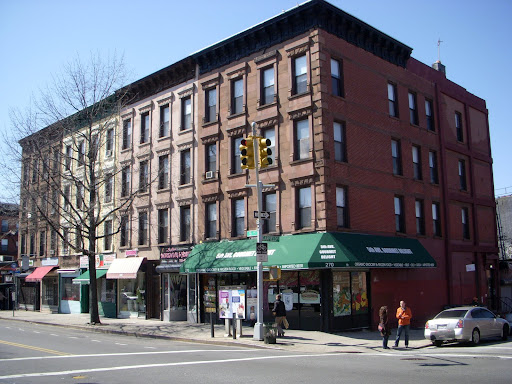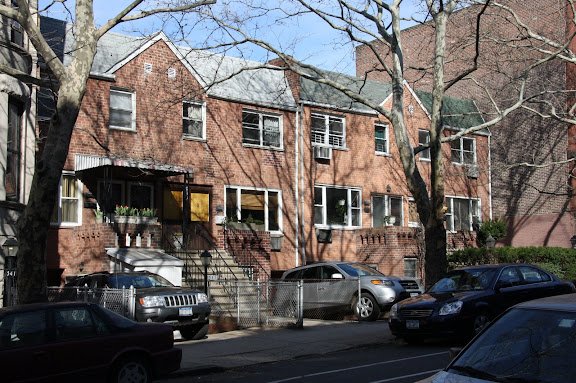Why this Blog Exists
To make the case for expanding the Park Slope Historic District
Tuesday, October 28, 2008
"Non-Contributing" in Second Street
Are the buildings pictured above, in 2nd Street between 7th & 8th Avenues, "historic"?
According to the Dept. of Buildings database, they were built in 1955. Note the auto-centric design: the front yards are parking lots.
It may be surprising to discover buildings like these within the boundaries of the Park Slope Historic District, which was designated in 1973, when these buildings were less than 30 years old. These are what are called "non-contributing" buildings: they do not contribute to the historic fabric of the district. However, the important point is that all the surrounding buildings contribute to the fabric of the historic district; therefore these buildings were included in the district as well so that the district would not have "donut holes".
Saturday, October 25, 2008
Brick-faced Neo-Grec
The Neo-Grec style emerged in the 1870s-1880s as a reaction to the earlier Italianate style. Whereas the Italianate style was characterized by more naturalistic forms such as the rounded, cave-like entrance, the Neo-Grec style reverted to the square doorway that had characterized the even earlier Greek Revival style. The naturalistic, plant-like carving on the brackets supporting the Italianate door hood gave way to machine-made, geometric incisions around the Neo-Grec doorway and windows. Another Neo-Grec innovation was the full-height, two-sided projecting bay, which allowed larger windows to bring more light into the interior. The Neo-Grec houses below, in Berkeley Place between 6th & 7th Avenues in the Park Slope Historic district, are brick with brownstone trim and were begun in 1886.
Neo-Grec houses are very common all over Park Slope. The row below is nearly identical to the row above and stands in Garfield Place, between 6th & 7th Avenues, outside the current historic district:
Below is another example of the common brick-with-brownstone-trim neo-Grec style in Park Slope. These are from 7th Street between 6th & 7th Avenues. Like the houses above, the ones below exhibit a distinctive fan-shaped detail at the upper corners of the windows:
Neo-Grec houses are very common all over Park Slope. The row below is nearly identical to the row above and stands in Garfield Place, between 6th & 7th Avenues, outside the current historic district:
Below is another example of the common brick-with-brownstone-trim neo-Grec style in Park Slope. These are from 7th Street between 6th & 7th Avenues. Like the houses above, the ones below exhibit a distinctive fan-shaped detail at the upper corners of the windows:
Friday, October 17, 2008
5th Ave. Contrasts
Today, two perspectives on Park Slope's 5th Avenue.
At Garfield Place, these 19th-century buildings, with their narrow storefronts, house many "mom-and-pop"-style businesses. The buildings are multi-purpose, with commercial on the first floor and apartments above. We particularly like the quoins on the corner building.
 5th Ave. at Garfield Place
5th Ave. at Garfield Place
Meanwhile a bit further south at 10th Street we find an entirely different kind of building. This one, built within the past few years, houses a national chain store. It is entirely commercial; i.e. no apartments above. Except for a parking lot, this "little box" store is identical to those found in suburban strip malls anywhere in America:
These pictures starkly highlight how physical buildings themselves can foster (or suppress) a particular business climate. Which structures are welcoming, which encourage strolling, lingering, and window-shopping? Which structure says, get what you need and then get out of here? Which corner has a unique "sense of place"?
At Garfield Place, these 19th-century buildings, with their narrow storefronts, house many "mom-and-pop"-style businesses. The buildings are multi-purpose, with commercial on the first floor and apartments above. We particularly like the quoins on the corner building.
Meanwhile a bit further south at 10th Street we find an entirely different kind of building. This one, built within the past few years, houses a national chain store. It is entirely commercial; i.e. no apartments above. Except for a parking lot, this "little box" store is identical to those found in suburban strip malls anywhere in America:
These pictures starkly highlight how physical buildings themselves can foster (or suppress) a particular business climate. Which structures are welcoming, which encourage strolling, lingering, and window-shopping? Which structure says, get what you need and then get out of here? Which corner has a unique "sense of place"?
Tuesday, October 14, 2008
Remuddling in 9th St.
These two buildings in 9th St. between 4th & 5th Avenues were once twins. Both are 8-family walk-up "flats", originally two apartments per floor. But the building on the left has lost the twin full-height, three-sided bays, leaving replacement double windows and mismatched brick scars running up the facade where the bays used to be. The cornice is completely obliterated.
Oddly, in the face of all this destruction, the original horizontal banding between the upper floors was thoughtfully extended across the full width of the facade... a nice touch? Or just weird?
Italianate in 7th Street
Park Slope's side streets are a veritable treasure trove of 19th-century building styles. Some of our recent posts have highlighted the Italianate style, characterized by a flat front, slightly rounded door and window embrasures, and parlor windows that drop all the way to the floor. This fine row of circa-1865 brick-front Italianate houses stands in 7th Street between 6th & 7th Avenues, outside the boundaries of the Park Slope Historic District. These are among the earliest houses in Park Slope.
The houses above face a nearly identical row across the street, below:
Many of these houses retain the original Italianate ironwork on areaways and stoops:
Wednesday, October 8, 2008
Park Slope Neighborhood History Guide

Francis Morrone has released his new book about Park Slope, part of a series of "neighborhood guides" published by the Brooklyn Historical Society. Entitled "Park Slope: Neighborhood & Architectural History Guide", the book is essential reading for anyone with a passing interest in Park Slope's history.
The book is available from the Brooklyn Historical Society and, soon, from the Park Slope Civic Council.
Subscribe to:
Posts (Atom)


